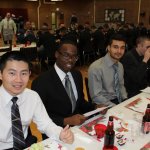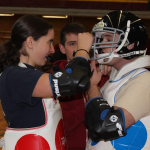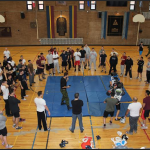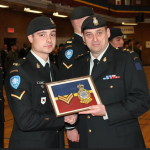Story and photos by Buzz Bourdon (late the RMR 1975-82)
 Every December, the officers and soldiers of The Royal Montreal Regiment gather in their venerable armoury to celebrate the Christmas season by sharing a traditional meal together in a spirit of good cheer and fellowship.
Every December, the officers and soldiers of The Royal Montreal Regiment gather in their venerable armoury to celebrate the Christmas season by sharing a traditional meal together in a spirit of good cheer and fellowship.
This year, the dinner was held on 13 December 2014 and featured the traditional Christmas dinner of turkey, mashed potatoes, peas, carrots, coleslaw, buns, small tourtiere pies and dessert. The turnout was excellent, with about 100 people tucking into the meal provided by the Canadian Forces’ Longue Pointe garrison.
The dinner, along with the preceding sports, was presided over by the RMR’s commanding officer, LCol Paul Langlais, and the newly appointed regimental sergeant-major, MWO DR Cochrane. Major George Siket, the deputy commanding officer, was also present.

After signing the paysheet, the troops changed into sports gear and spent most of the morning participating in a vastly popular pugil stick fighting competition. Designed to instill an offensive spirit, the competition featured two people battering each other with thickly padded pugil sticks. Each person was amply protected with a football helmet, hockey gloves and body padding.
The action was fast and furious, with many participants earning roars of approval from their peers through their fighting spirit. The referee was MCpl Elias Aoun, a qualified close quarter combat instructor.
When the dust had settled, the overall victor was Cpl Robert Duma. Pte Chris Randall was second.
 Off to the side, along the armoury’s north wall, teams of soldiers hauled and sweated in various tug of war competitions. Nearby, some hard-fought arm wrestling bouts attracted attention. The winner was Cpl Antoine Legault, with Sgt Mazen El-Khoury finishing second.
Off to the side, along the armoury’s north wall, teams of soldiers hauled and sweated in various tug of war competitions. Nearby, some hard-fought arm wrestling bouts attracted attention. The winner was Cpl Antoine Legault, with Sgt Mazen El-Khoury finishing second.
While the junior ranks were changing into service dress, complete with undress medal ribbons, the officers and senior non-commissioned members scurried around the parade square, laying the tables with napkins, buns, plastic glasses, forks and knives. When all was ready, the RMR formed up in three ranks for a short parade and several presentations.
 CWO William Crawford, the 27th RSM of the RMR who relinquished the position in November, at the Remembrance Day parade, was presented with the second clasp to his Canadian Forces Decoration by LCol Langlais. The CD is awarded for 12 years of service and good conduct. Some say, tongue in cheek, that it really means 12 years of undetected crime. Clasps are awarded for each subsequent decade of service. CWO Crawford has served 32 years so far.
CWO William Crawford, the 27th RSM of the RMR who relinquished the position in November, at the Remembrance Day parade, was presented with the second clasp to his Canadian Forces Decoration by LCol Langlais. The CD is awarded for 12 years of service and good conduct. Some say, tongue in cheek, that it really means 12 years of undetected crime. Clasps are awarded for each subsequent decade of service. CWO Crawford has served 32 years so far.
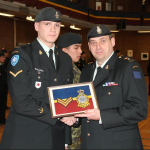 The commanding officer then distributed four eagerly awaited promotions. JP Vallieres, Thomas Ritchie-Burger and Duy Oum all received the second stripe which made them corporals. Connor McLeod was promoted to the rank of master corporal, which features a small maple leaf over two stripes.
The commanding officer then distributed four eagerly awaited promotions. JP Vallieres, Thomas Ritchie-Burger and Duy Oum all received the second stripe which made them corporals. Connor McLeod was promoted to the rank of master corporal, which features a small maple leaf over two stripes.
Promotions are tangible evidence that the soldier has gained experience, is doing well in his job, has shown qualities of leadership and is trusted to do even better in the future. It also means more pay and increased responsibilities. For example, a master corporal may now command a second of ten or so soldiers and be responsible, in part, for their attendance, morale, training and administration.
 Much later in the day, sounds of revelry and congratulation was heard from the Junior Ranks Mess as the four celebrated their promotions by ringing the bell and buying, each in their turn, a round of drinks for their peers. That is a very old tradition that goes back decades in the RMR and the army.
Much later in the day, sounds of revelry and congratulation was heard from the Junior Ranks Mess as the four celebrated their promotions by ringing the bell and buying, each in their turn, a round of drinks for their peers. That is a very old tradition that goes back decades in the RMR and the army.
Finally, it was time to eat and the officers and senior non-commissioned officers served the soldiers with the dinner. Many wore a plastic apron and the white cook’s hat normally seen in Canadian Forces’ kitchens. Serving the troops at this yearly event is a way for the unit leadership to thank the soldiers for their hard work, dedication and professionalism displayed over the past year.
 The Department of History and Heritage, of the Canadian Forces, explains the tradition on its website. “Before the introduction of mechanization and sophisticated systems of logistics in the 20th century, enlisted personnel occupied much of their time in tedious routine. In an effort to boost morale, and to show general appreciation for junior ranks, officers took it upon themselves to organize celebrations for the enlisted ranks. One tradition that has been preserved over the ages has been the Christmas dinner. Officers and senior non-commissioned officers not only organize the dinner, but they also prepare and serve it to the junior ranks of their unit. When the dinner is over their task is not complete until they clean up.”
The Department of History and Heritage, of the Canadian Forces, explains the tradition on its website. “Before the introduction of mechanization and sophisticated systems of logistics in the 20th century, enlisted personnel occupied much of their time in tedious routine. In an effort to boost morale, and to show general appreciation for junior ranks, officers took it upon themselves to organize celebrations for the enlisted ranks. One tradition that has been preserved over the ages has been the Christmas dinner. Officers and senior non-commissioned officers not only organize the dinner, but they also prepare and serve it to the junior ranks of their unit. When the dinner is over their task is not complete until they clean up.”
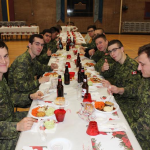 DHH says that all this tradition stems from the ancient Roman custom of Saturnalia. “The festival of Saturnalia honors Saturn and falls at the same time as Christmas, Hanukkah, Solstice and/or Kwanzaa. Christmas decorations such as swathes, garlands, wreaths and tree ornaments began with the merriment of Saturnalia. During the time of Saturnalia slaves and children got to be waited on for meals, lead the rituals, and participated in the revelry as if they were their parents/masters. The parents/masters jokingly played the part of children and slaves by waiting on them. The role reversal was symbolic as slaves were not really free to make decisions as free persons nor were children able to enter into contracts or make business deals. Role reversal was only for minor privileges.”
DHH says that all this tradition stems from the ancient Roman custom of Saturnalia. “The festival of Saturnalia honors Saturn and falls at the same time as Christmas, Hanukkah, Solstice and/or Kwanzaa. Christmas decorations such as swathes, garlands, wreaths and tree ornaments began with the merriment of Saturnalia. During the time of Saturnalia slaves and children got to be waited on for meals, lead the rituals, and participated in the revelry as if they were their parents/masters. The parents/masters jokingly played the part of children and slaves by waiting on them. The role reversal was symbolic as slaves were not really free to make decisions as free persons nor were children able to enter into contracts or make business deals. Role reversal was only for minor privileges.”
DHH finishes by saying that “specific traditions during the Christmas season can vary amongst environments and units in the Canadian Forces, For example, in the navy, Christmas lights and decorations have been used to decorate trees, streets, buildings and a ship’s yardarms. In many cases there is an active competition to see who has the best decorations.”
On the RMR’s parade square, near one end of the head table, a three-foot table was set with an empty place setting, to symbolize the missing soldier. He symbolizes all the RMR soldiers who lost their lives in two world wars.

At the head table, another old Christmas military tradition was faithfully observed as LCol Langlois traded jobs with the youngest private in the RMR, Pte Christopher Marchand, 17. “I’m honoured but a little nervous,” confided the Dawson College business management student. Wearing the real CO’s jacket, complete with his brand new rank insignia of a crown and star on each epaulette, plus medal ribbons, the young man was now CO of the RMR for the day.

Also sitting at the head table was Cpl Frank Laciak, 46, who was honoured by being appointed RSM for the day, complete with MWO Cochrane’s jacket. This newer tradition sees the oldest corporal trade his uniform jacket with the RSM. Cpl Laciak, a finance clerk, has been in the RMR for 25 years.
The very first Christmas dinner held by the RMR was held exactly 100 years ago under very different circumstances than this year’s.
The RMR, which had been organized in August, 1914, as the 14th Battalion, Canadian Expeditionary Force, part of the First Contingent of Canadian troops sent to fight in the First World War, was billeted in huts at Larkhill, in England. The weather was atrocious, with rain and mud making training and daily life a misery.
On Dec. 11, 1914, the Montreal Daily Mail reported on page one that the troops would enjoy Christmas dinner, courtesy of the Canadian government. The headline read, “Xmas Dinner For / Canadian Troops. Dominion Government will Provide Seasonable Cheer for Every Member of Force.”
“Ottawa, Dec. 10. – The Government has decided to provide a Christmas dinner for every man on active service in Canada. This will include the men of the Second Contingent, and also those who are being recruited for future contingents and reinforcements. There are now over 30,000 men on active service, besides the 3,000 on guard duty so that the Government will have at least 40,000 Christmas dinners to provide.”
Volume One of the regimental history, written by RC Fetherstonhaugh, described that first Christmas. “Many officers and men were granted leave over one or another of the dates. Those remaining on duty decorated the huts, ordered parcels of special food and drink from London, organized sing-song hut parties, and endeavoured to forget for a few hours the constant rain, the all-pervading mud, and the endless digging and draining which the atrocious weather made necessary.”
Two years later, the 14th Battalion’s Christmas dinner was held on Dec. 25, 1916. The unit, which in almost two years had fought in many battles, had been enjoying rest billets for three days, at Brauy, wrote Fetherstonhaugh. “At Bruay, the Battalion passed Christmas and welcomed the new year. The men were comfortably billeted in houses and buildings of the town. Routine training was carried out on each day and on Christmas all who so desired it were given an opportunity to partake of holy Communion, or attend the celebration of Mass. No parades were held and the holiday was marked by a special dinner for the men, the bill of fare including a few unusual items such as port wine and cigars. In the evening, the officers held a memorable dinner in the principal local hotel. Canon Scott, one-time principal Protestant Chaplain of the Regiment, was the guest of honour.”
In fact, the RMR was overseas for five consecutive Christmases during the first war and was lucky to be out of the line for each one. The first one was held in England, the second in divisional reserve at Kortepyp (1915), the third in rest billets at Bruay (1916), the fourth in div reserve at St Lawrence Camp (1917) and the final one, in 1918, across the Rhine, in Unter Eschbach, in occupied Germany.
That final dinner of the 14th Battalion must have been extremely poignant for those present. They had survived the war when 1,192 RMR soldiers had not. Now they would live to return to Canada, home and loved ones.
Fetherstonhaugh set the scene in his Volume One. “Snow fell heavily during the night of Dec. 24, with the result that when reveille wakened the Royal Montrealers on Christmas morning the scene bore all the marks of Canada. Turkeys, promised for dinner, failed to arrive, but the Battalions cooks produced a meal that all declared excellent.”
Number One and Four Companied dined together, he said, as did Headquarters and No. 2 Coy, but No. 3 Coy elected to eat by itself. “Beer, rum, punch, dates, apples, figs and oranges were supplied to the men for dessert, and the tables were waited on by the officers and Senior NCOs. Lieut.-Col. (Dick) Worrall visited each party and was everywhere received with cheers, the men being proud of the fact that he had left Canada in the ranks of the Battalion and had risen through devoted service to command. At each dinner, in acknowledgment of the greeting, he expressed deep satisfaction in commanding such a Regiment.”
Later that day, the Sergeants inaugurated their mess with a dinner that will “live long in the memory of all privileged to attend. At 8 o’clock the officers dined in a hall about a mile from billets. Preparation for this event had been placed in the hands of Capt. J.E. McKenna, M.C., who achieved a great success.”
During dinner the Battalion band played, Fetherstonhaugh wrote, “and from a tree, each guest received a gift bearing some relation to present behavior, or personal idiosyncrasies. The first toast was, of course, “The King,” which all drank with traditional ceremony. Capt. McKenna then proposed, “The Commanding Officer,” which evoked prolonged cheers. The third and last toast of the evening, “Absent Comrades,” was proposed by Major C.B. Price, and honoured in impressive silence.”
In view of the splendid and joyous celebrations held on Christmas, the laconic entry of the Battalion diary on Dec. 26th, “no parades were held,” provoke a smile, wrote Fetherstonhaugh.
The tradition continued after the war, held in the RMR’s splendid new armoury that opened Dec. 28, 1928. Twenty-five years after mobilizing for the first war, the RMR answered the call to arms for a second time in September, 1939. Three months later, the 1st Battalion was in England, in Albuhera Barracks, in Aldershot. “Invitations for officers and other ranks to share in Christmas festivities poured in from unknown
friends in all parts of the British Isles and, through the acceptance of them, many lasting friendships with the people of Britain were formed. On Dec. 24, the Battalion paraded at 10:15 a.m. and attended divine service in St George’s Church. “Special dinners were served in all messes on Christmas; and on Boxing Day, parades were cancelled,” wrote Fetherstonhaugh in volume two of the RMR”s official history.
To sum up, it is almost certain that the RMR has held this traditional dinner every single year of its existence, for a total of 100 Christmas dinners in all. It is a chance for all ranks to celebrate a common holiday and slightly relax the rigid barriers of rank. A good meal coupled with a festive atmosphere makes the traditional occasion an event to remember.






